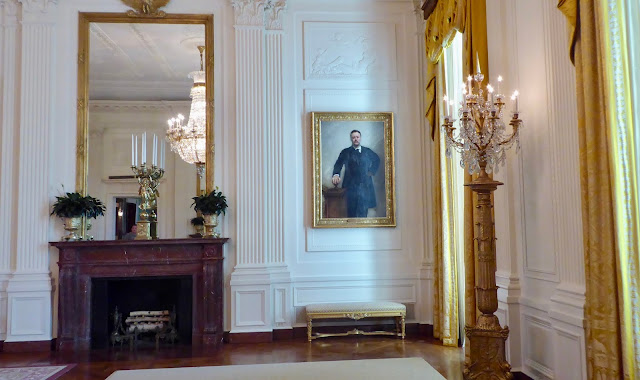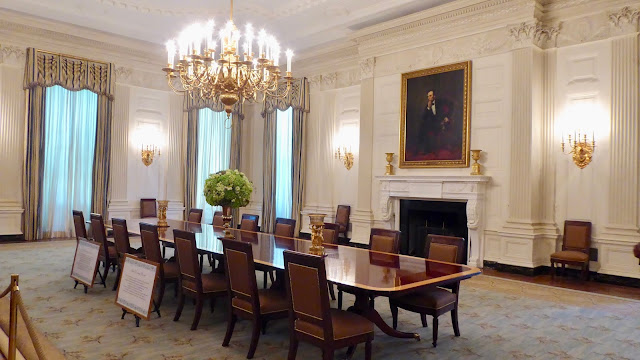 |
| Bancroft Hall |
Carol writes: Our plan to arrive in the Annapolis, Maryland, area three weeks ahead of the 50th reunion for the US Naval Academy Class of 1969 unfolded perfectly for us. Over that three weeks, we were able to visit all of the venues in the nation’s capital that had languished thus far on the bucket list.
THE YARD
Prior to the hectic week of reunion festivities, Al and I took advantage of the opportunity to take a leisurely trip down memory lane on the US Naval Academy campus. From the moment we entered Gate 1 onto the stately Academy grounds known as the “Yard,” Al’s archive of memories began to unspool. The Yard had changed a lot since the early days when it was established by Secretary of the Navy George Bancroft in 1845.
Activities in historic Dahlgren Hall during plebe year generated fits of laughter in both of us as Al recalled those awkward “tea dances” (commonly called "tea fights") in Dahlgren Hall,
where guys were paired up with girls in line behind a privacy screen that revealed nothing more than their feet and ankles. Computer dating websites of today have pics and bios; the poor plebes of 1969 had only feet and ankles beneath a privacy screen… This ritual took place on the historic wooden floors of today’s century-old Dahlgren Hall, named after Rear Admiral John Dahlgren, inventor of large-caliber naval guns.
From Dahlgren Hall, we headed toward the historic Main Chapel at the center of the Yard.
The dome of the Chapel was covered in repair scaffolding, but the interior of this historic place of worship, where USNA cadets receive moral and spiritual guidance, was meticulously maintained.
Beneath the chapel, we paid respects at the crypt of John Paul Jones, Father of the US Navy.
Jones grew up in a humble home in Scotland
and would eventually play a vital role in assisting our Continental Navy during the American Revolutionary War.
In the vicinity of the chapel, we passed nostalgic Herndon Monument. Al retold the story about the end-of-plebe-year tradition of replacing a plebe dixie cup hat with an upperclassmen’s cap on the top of greased Herndon monument. Teamwork was the key!
Massive Bancroft Hall, home to the entire brigade of midshipmen, was elegant and unblemished, largely unchanged since Al received his first room assignment over 50 years ago during plebe summer. Throughout plebe summer, Al’s room was behind the windows to the right of the “2nd CLASS DOORS.”
Bancroft Hall has the distinction of being the largest college dormitory structure in the country.
This Beaux-Arts-style beauty retained its grandeur inside as well. The “Don’t Give up the Ship” Navy motto visible in Memorial Hall at the top of the rotunda steps could not be missed…
Beneath the spectacular vaulted ceiling of Memorial Hall, a series of memorial plaques and displays honored Naval Academy alumni who have died in military operations. Familiar names on the walls brought back somber memories.
A visit to the sailing basin
initiated remembrance of a late classmate from the Class of 1969 who was Al’s roommate nearly all four years at the Academy. Eric persuaded Al to be his sailing partner one day as they headed to the boat basin for the very first practice. And that is how a friendship was born that endured for over five decades…
Boats similar to the ones Al and Eric sailed competitively for two years created a lovely tableau along the shore of the Severn River, where the age-old contest featuring humans, wind, water, and boats played out silently and beautifully before us.
The tacking maneuver performed by this women’s sailing team was thrilling to watch.
We popped inside a few random academic buildings, such as:
the relatively new Wesley Brown Fieldhouse;
Macdonough Hall, named after Captain Thomas Macdonough, USN, who achieved fame in the war of 1812;
and Luce Hall, with the statue of Medal of Honor recipient Admiral James Stockdale at the entry.
The SEANAV classrooms of Luce Hall were where Al’s lessons in ship-driving first began with navigation charts at old wooden tables.
On exiting the Yard, the Navy Goat reminded us of the homecoming game against Tulane that we would attend during reunion festivities in a couple of weeks.
On the way back to the car, we made a brief stop in the Maryland State Capitol building
across from the equally lovely governor’s mansion.
THE REUNION
For the next five days of reunion festivities, I would observe up close a brotherhood of Navy and Marine men and marvel at the strength of their bonds.
WEDNESDAY, DAY 1—
A wonderful Wednesday afternoon private tour of Mt. Vernon, home of President George Washington,
was led by Amanda, daughter of one of Al’s classmates. This historic home continues to undergo renovation to make all aspects of the home as accurate as possible. The exterior white color was recently refurbished with a more historically accurate tan color.
Some of the more fully restored rooms were:
the dining room,
a guest room,
and George Washington’s bedroom.
The 3 p.m. wreath ceremony at Washington’s tomb
was led by the three veterans in the crowd—Jim, Pem, and Al.
I couldn’t have imagined a more fitting way to conclude our visit to Washington, DC than a wreath ceremony at the tomb of our first President.
THURSDAY, DAY 2—
At the intimate Thursday night gathering of the 25th company, I observed seeds of friendship sprout and flourish once again after being sown over 50 years ago in an environment of rigorous academic, physical, and mental testing. Al had a wonderful time meeting up with classmates we had visited on the road, in addition to those he had not seen in 50 years. To a person, I marveled at the achievements of the men of the 25th Company across a wide variety of life experiences. Among them were military leaders, executives of industry and commerce, selfless teachers of future generations, and volunteers of distinction.
Al had his own Admiral Rickover interview story, and throughout the evening we heard additional stories that we had never heard before.
FRIDAY, DAY 3—
The Friday night formal dinner for the entire class was held in the banquet rooms of the Graduate Annapolis Hotel. The 25th Company had three tables in the impressive atrium room.
Keepsake company photographs were taken after dinner.
 |
| 25th Company, Class of 1969 (photo courtesy of Joyce Ellen Richards) |
SATURDAY, DAY 4—
Saturday afternoon the annual homecoming game was played at Navy-Marine Corps Memorial Stadium. All week long banners saying “Beat Tulane” had been a common sight. This time, from the comfort of seats in the stands, the Class of ’69 got to observe the ceremonial parachutist float onto the field, with the Stars and Stripes waving in the wind,
followed soon thereafter by the entire brigade of midshipmen marching onto the field.
From our seats in Section 1,
we had a great view of the halftime show put on by the Naval Academy Drum and Bugle Corps.
The capstone on the day was an epic Navy win over Tulane (41-38), with a field goal in the last second of the game! A more exciting finale could not have been scripted better!
SUNDAY, DAY 5—
Sunday afternoon a solemn memorial service was held for all those members of the Class of 1969 who are no longer with us. The weather outside seemed in keeping with the somber mood of the service, for it had been raining nonstop all morning. However, at the halfway point of the service, a sudden influx of sunlight was broadcast through the windows of the chapel dome high above just as the solemn recitation of the names commenced for those who have passed since the last reunion…
After another class picture on the steps of the chapel, followed by fond goodbyes and wishes for safe travel home, we slowly slipped off for a quiet goodbye of our own—past the lush green parade grounds of Worden Field,
then over to the US Naval Academy Cemetery where John McCain lies in peaceful repose next to his classmate, in the company of many great heroes.
The McCain gravesite was not hard to find—it was the one with innumerable coins and tokens of remembrance at the headstone.
We paid our respects to John Sidney McCain, then simply departed through the gates of the Yard in a suitable end to an emotional day of remembrance for those who have led exemplary lives in service to our country.
I will have more to say in a future blog about our nearly 5 years of life on the road, with commentary on what I think we accomplished and what it meant to us.
But for now, this long meandering adventure, packed with the thrills of many lifetimes, has come to an end…
in Maryland,
on the shore of the Severn,
at the the gate of the USNA Yard.
Carol Galus
Photo-Blogger



























































































